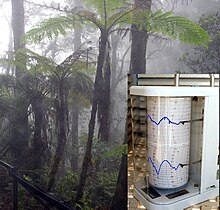
| Humidity and hygrometry |
|---|
 |
| Specific concepts |
| General concepts |
| Measures and instruments |
A hygrometer is an instrument which measures the humidity of air or some other gas: that is, how much water vapor it contains.[1] Humidity measurement instruments usually rely on measurements of some other quantities such as temperature, pressure, mass, and mechanical or electrical changes in a substance as moisture is absorbed. By calibration and calculation, these measured quantities can be used to indicate the humidity. Modern electronic devices use the temperature of condensation (called the dew point), or they sense changes in electrical capacitance or resistance.
The maximum amount of water vapor that can be held in a given volume of air (saturation) varies greatly by temperature; cold air can hold less mass of water per unit volume than hot air. Thus a change in the temperature can change the humidity.
A prototype hygrometer was invented by Leonardo da Vinci in 1480. Major improvements occurred during the 1600s; Francesco Folli invented a more practical version of the device, and Robert Hooke improved a number of meteorological devices including the hygrometer. A more modern version was created by Swiss polymath Johann Heinrich Lambert in 1755. Later, in the year 1783, Swiss physicist and geologist Horace Bénédict de Saussure invented a hygrometer that uses a stretched human hair as its sensor.
In the late 17th century, some scientists called humidity-measuring instruments hygroscopes; that word is no longer in use, but hygroscopic and hygroscopy, which derive from it, still are.
- ^ This is different from measuring the moisture content of something non-gaseous like soil, where liquid water is part of the measurement.